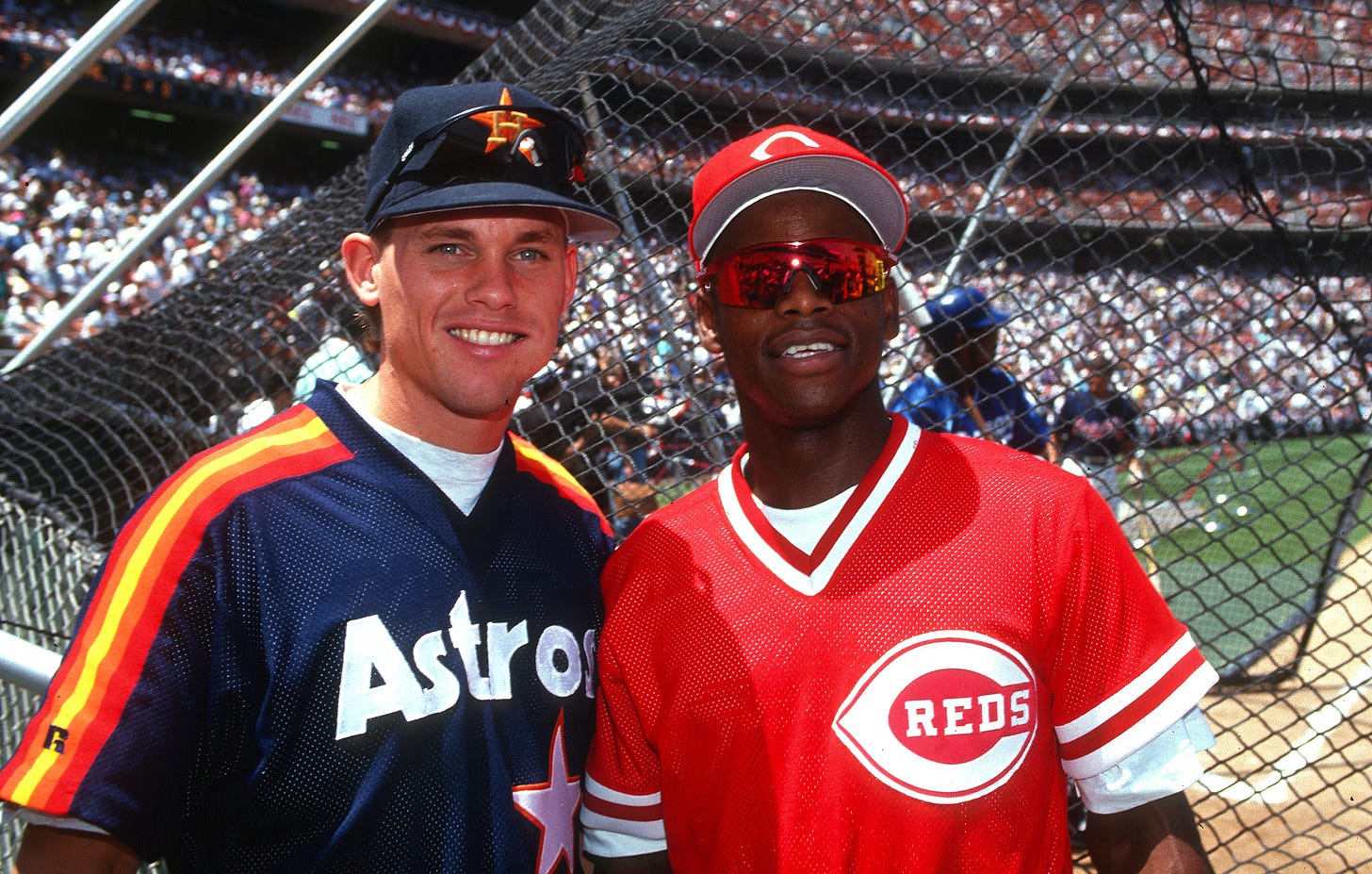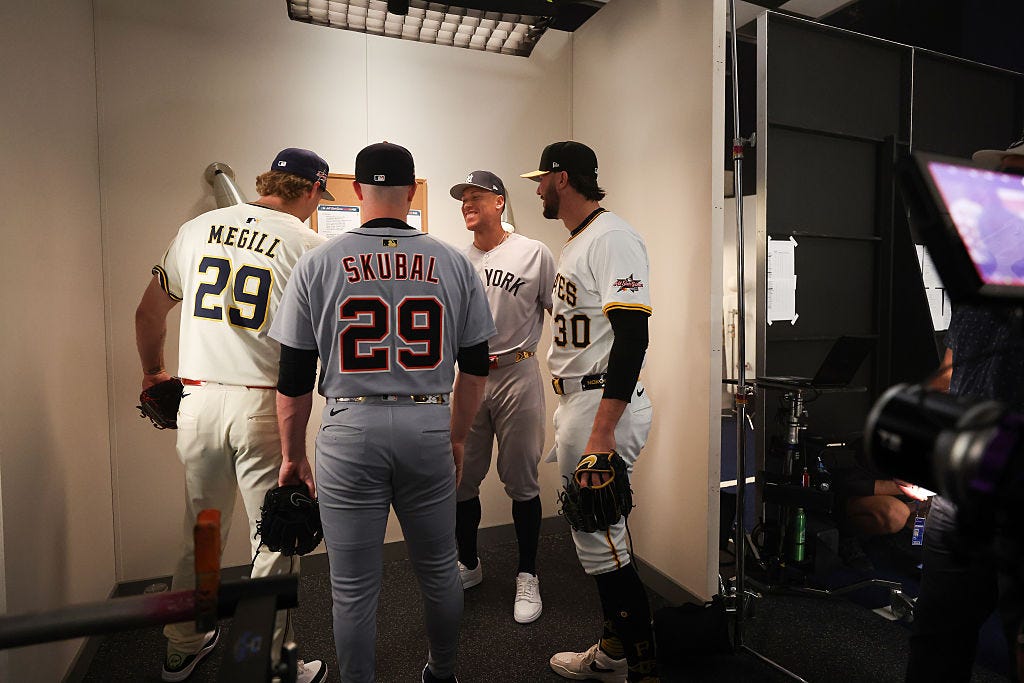
As a child of the ‘80s, I remember living in a vibrant world saturated with color. The music blaring from boom boxes felt almost visible, so loud and immersive it seemed to ripple through the air. Add in the bold hues of my favorite sports teams, and it felt like color was everywhere, punctuating every moment with team spirit and energy. Maybe it is just how vividly we perceive things when we are young, regardless of the decade, but baseball in the ‘80s felt especially loud, bright, and alive.
There was nothing muted about baseball back then. Bright yellows, oranges, powder blues. Road uniforms required sunglasses just to watch. And then there was the Astros who crammed every warm shade of orange in the spectrum onto one atmospheric jersey. There were no rules. Clash equaled cool.
Tonight’s All-Star Game takes us back from 2025 to a time that crystallized my fandom. For the first time in years, the players will wear their own team jersey instead of matching All-Star uniforms. It is a return to yesteryear. When I spoke to AL manager Aaron Boone last week, he reminisced about attending the 1979 All-Star Game with his dad (who was catching) and feeling excited by the sight of players wearing the “wrong uniforms in the wrong ballparks.”
That kind of natural absurdity was part of the magic, the strange thrill of seeing mismatched uniforms and teams that never played against each other now sharing the same field. Back then, the American and National Leagues were binary, siloed. So the All-Star Game felt like a glimpse into an alternate universe. I could not stop imagining what would happen if these teams played in a game that counted in the standings. What kind of baseball black hole might that open up?
When interleague play became reality in 1997, I was a young big leaguer. I remember thinking it might ruin the mystique. Before then, AL and NL teams only met in the World Series or spring training, and that made perfect sense to me. Orioles vs. Phillies? That almost seemed illegal. Like watching an Instagram clip of a rhino and a poodle playing. Sure, it’s cool, but how long can it last before something goes sideways?
In that first interleague season, I played with the Cubs against the White Sox in a regular-season game. It felt like the Earth’s axis had shifted. Sure, before that, Chicago had its own intercity rivalry, the annual Mayor’s Series exhibition, later known as the Chicago Crosstown Classic, which even Michael Jordan once played in. But interleague play was official, not exhibition.
Now, cross-league match-ups happen daily as part of a balanced schedule. It is great that fans everywhere get to see Aaron Judge or Shohei Ohtani in person. But, the lines between the two leagues have blurred. DH in both leagues. Constant crossover games. I am not sure what the distinction is any more. Every time I say on air that someone is leading the league in a category, I have to stop and ask: which league?
Still, I loved the novelty of interleague play. It gave me the opportunity to visit new ballparks and face pitchers I had only heard about. As a lifelong National League fan, I took it personally. Every game felt like a battle for bragging rights. So when I signed with the Rangers in 2003 to leave the NL and officially join the American League, I had to take a deep breath. I remember one night, after a game during my best season, seeing my name at the top of the leaderboard for interleague hits. What a thrill!
Switching leagues also meant adjusting my instincts. I remember one game with Texas where we were lighting up a Mariners starter. I expected him to be taken out, but there he was, still on the mound the next inning. In the NL, the manager would have substituted a pinch hitter for him the first chance he got. I asked why he was still out there, and a teammate reminded me, “This is the American League. He can eat up more innings.” I just kept thinking, “Yeah, but we are beating him to a pulp. More innings means more runs!” Now, with the universal DH, that kind of decision-making is standard. A dance between innings and matchups is the norm in 2025.
The All-Star Game has always been a time when we suspend disbelief. But in the ‘70s and ‘80s, color was one key part of what made that suspension feel possible. For one night, all the hues came together in a chaotic, glorious canvas. A clearly identifiable Pirate throwing to an Expo to cut down an Angel at the plate? For 364 days of the year, that made absolutely no sense unless you were scripting a baseball horror movie. But on All-Star night? We embraced the madness.
In 1979, Nolan Ryan opened the game pitching to Davey Lopes, Dave Parker, and Steve Garvey. Back then, I half-believed these guys needed special baseball passports just to share the same field. But for this one event, all boundaries vanished. It was not about teams anymore. We simply found out which was the better league.
The uniforms made it all real. Nothing was uniform about it, and that was the point. You could instantly spot your favorite players and teams. We marveled at the sheer impact of the defense looking like a living kaleidoscope of colors, with each jersey a time stamp and flag from a different corner of baseball’s map. They were temporarily united under a truce, just for one night. Unless of course, your team’s colors matched those of the stadium that year. Then you were a hero.
My love for the Phillies started with their powder blue uniforms. The players and the wins came after. Every chance I could see them in those uniforms, it was a win. As a seven-year-old, the logic was simple. These were color wars, not just baseball games. I knew who was friend and who was foe based on the uniforms. There was no mistaking who the Phillies were on the road.

I am thrilled that MLB brought back the color chaos. The overstimulation that defined ‘70s and ‘80s baseball. It brightens the mood. It helps us find home. I remember wearing the Phillies powder blues for a turn-back-the-clock game in Atlanta and hitting a home run off Tom Glavine. I credit the uniform, channeling the kid in me who used to dream of that moment.
The ‘80s were big, bright, and enjoyably ridiculous. And, we loved every minute of it. The music videos, the over-the-top everything, the hair (I’m from New Jersey, after all), the cartoons, and the era when baseball was on top of the world. The more we can recapture that spirit, the better.
Not everything from that era deserves a comeback. We tried reviving the bullpen cart, but it flopped. Turns out pitchers did not want to ride. They preferred the adrenaline-fueled jog in from the bullpen. And really, can you imagine Edwin Díaz storming in from the Mets’ bullpen to Timmy Trumpet’s Narco… in a cart? It just would not hit the same notes.
But some things from the ‘80s are absolutely worth bringing back. The color. The energy. Because those things did not just define the era, that kind of boldness never goes out of style.
Tonight, I will be on the call for ESPN Radio for the All-Star Game, and I fully intend to overshare about the uniforms. It is my duty. Because 1980s baseball was not just a game. It was a prism, a flash of electric psychedelia.
So let the All-Star Game be its rainbow again.





I just got a Clemente fridge magnet!
Well said Doug!